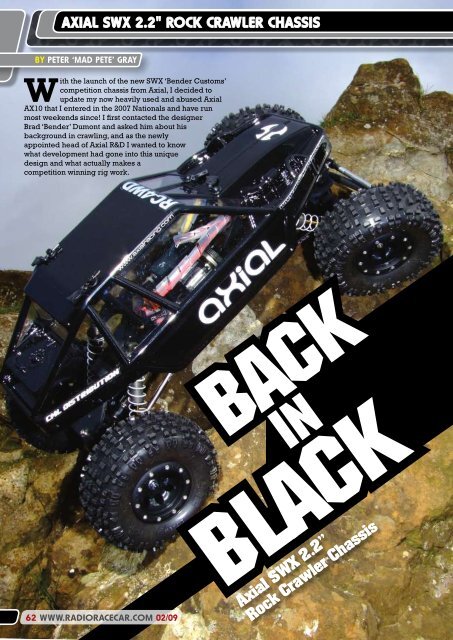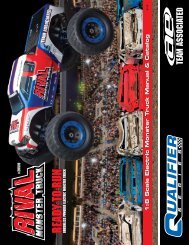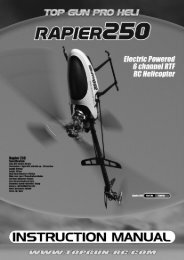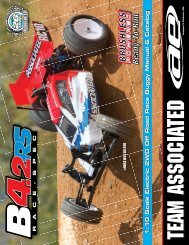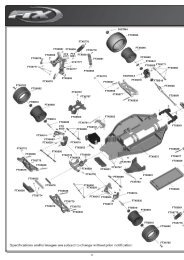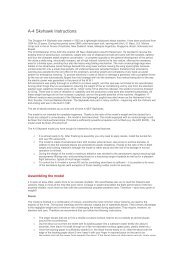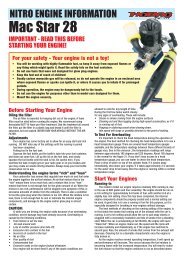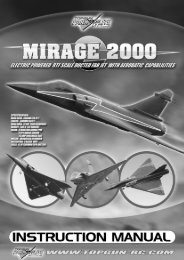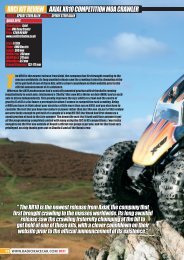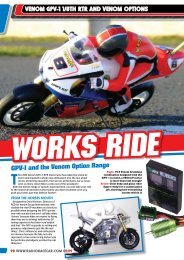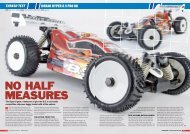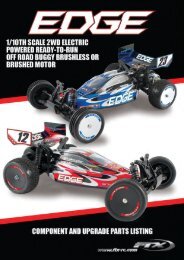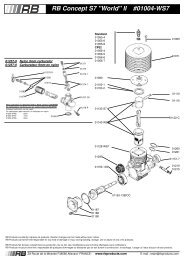Axial SWX Crawler reviewed in RRCi - CML Distribution
Axial SWX Crawler reviewed in RRCi - CML Distribution
Axial SWX Crawler reviewed in RRCi - CML Distribution
Create successful ePaper yourself
Turn your PDF publications into a flip-book with our unique Google optimized e-Paper software.
AxIAl sWx 2.2" ROCk CRAWlER ChAssIs<br />
By PEtER ‘MAD PEtE’ GRAy<br />
With the launch of the new <strong>SWX</strong> ‘Bender Customs’<br />
competition chassis from <strong>Axial</strong>, I decided to<br />
update my now heavily used and abused <strong>Axial</strong><br />
AX10 that I entered <strong>in</strong> the 2007 Nationals and have run<br />
most weekends s<strong>in</strong>ce! I first contacted the designer<br />
Brad ‘Bender’ Dumont and asked him about his<br />
background <strong>in</strong> crawl<strong>in</strong>g, and as the newly<br />
appo<strong>in</strong>ted head of <strong>Axial</strong> R&D I wanted to know<br />
what development had gone <strong>in</strong>to this unique<br />
design and what actually makes a<br />
competition w<strong>in</strong>n<strong>in</strong>g rig work.<br />
62 WWW.RADIORACECAR.COM 02/09<br />
back back<br />
<strong>in</strong><br />
black black<br />
<strong>Axial</strong> <strong>SWX</strong> 2.2”<br />
Rock <strong>Crawler</strong> Chassis
BItE My shINy DElRIN skIDPlAtE!<br />
Brad’s notoriety and the respect he’s garnered from<br />
enthusiasts worldwide all stems from his own product<br />
l<strong>in</strong>e that started with him compet<strong>in</strong>g <strong>in</strong> the 2.2" class <strong>in</strong><br />
Colorado and Moab. These competitions evolved <strong>in</strong>to<br />
him develop<strong>in</strong>g products such as the SW2, which Brad<br />
manufactured to sell to the general public under the<br />
name ‘Bender Customs’. The SW3 was the next chassis<br />
he designed which was essentially a no frills competition<br />
specification which went on to w<strong>in</strong> the 2007 RCCRawler.<br />
com ‘Peoples Choice Award’ for ‘Best Chassis’. After a<br />
short break from manufactur<strong>in</strong>g chassis, he designed the<br />
<strong>SWX</strong> chassis for <strong>Axial</strong> Rac<strong>in</strong>g’s AX10 kit. A culm<strong>in</strong>ation<br />
of four years of R&D, it’s by far the most compact and<br />
capable chassis he’s designed to date.<br />
‘MAD’ PEtE INtERVIEWs BRAD<br />
Here’s my <strong>in</strong>terview with the<br />
man himself, his thoughts and<br />
ideas on what makes a good<br />
competition rig perform and<br />
his views on the ever-grow<strong>in</strong>g<br />
crawler scene:<br />
Mad Pete: Where does the Bender <strong>in</strong><br />
Bender Customs come from then? I’m<br />
th<strong>in</strong>k<strong>in</strong>g Futurama, am I on the right<br />
track?<br />
Brad: You are correct, the name ma<strong>in</strong>ly<br />
comes from Futurama. That show cracks<br />
me up, and Bender is the best character<br />
on it <strong>in</strong> my op<strong>in</strong>ion<br />
So how long have you been <strong>in</strong>to R/C<br />
rock crawl<strong>in</strong>g?<br />
I’ve been R/C rock crawl<strong>in</strong>g s<strong>in</strong>ce 2000,<br />
but became heavily <strong>in</strong>volved with<br />
it when I stumbled upon RC<strong>Crawler</strong>.<br />
com <strong>in</strong> 2004. I won the 2006 USRCCA<br />
nationals with a rig I designed and built.<br />
Been compet<strong>in</strong>g all over the US for<br />
the last couple years. My first chassis<br />
design for the public was the SW2,<br />
which was designed to be a chassis<br />
that could be built with any axles out<br />
there. The next chassis was my SW3,<br />
which was designed to be strictly a 2.2<br />
comp chassis. Then I designed the <strong>SWX</strong><br />
hIs MAIN POINts ON BuIlDING A GOOD COMP RIG ARE As fOllOWs:<br />
• For a 4-l<strong>in</strong>ked chassis, l<strong>in</strong>k set-up, ride height<br />
and shock angle play the biggest role <strong>in</strong> how<br />
a rig performs<br />
• Have the upper and lower l<strong>in</strong>ks double triangulated<br />
• Ride height has to be set so the rig has a decent<br />
‘break over’ angle (ground clearance), but<br />
still set low enough to climb steep vertical faces<br />
• Driv<strong>in</strong>g style, as well as terra<strong>in</strong>, can play a big role<br />
too. Some people prefer wheel speed and some<br />
prefer a lot of torque, one set-up may not work<br />
for both situations. Experiment to see what’s<br />
good for you!<br />
around <strong>Axial</strong>’s AX10, which they decided<br />
to buy the rights too. I <strong>in</strong>terviewed with<br />
them shortly after that for a job as a<br />
product designer/R&D tester, which is<br />
now where I currently work <strong>in</strong> California.<br />
So where do you see rock crawl<strong>in</strong>g<br />
go<strong>in</strong>g <strong>in</strong> the future?<br />
For the future of R/C crawl<strong>in</strong>g I’d like<br />
to see the Super Class evolve more.<br />
I’m hop<strong>in</strong>g more companies will start<br />
to support this class. Right now there<br />
isn’t much support for it as far as<br />
aftermarket parts go. I th<strong>in</strong>k that’s the<br />
biggest reason that the attendance<br />
numbers for comps are down <strong>in</strong> that<br />
class. The 2.2 class seems to be gett<strong>in</strong>g<br />
all the attention lately, which is great to<br />
see but the Super Class is what really<br />
kicked this aspect of R/C off, and now it<br />
seems to have taken a back seat to the<br />
other classes. I also th<strong>in</strong>k that the scale<br />
trucks are go<strong>in</strong>g to receive a lot of<br />
attention over the next year. I can see<br />
more and more competitions popp<strong>in</strong>g<br />
up for them. Especially now that <strong>Axial</strong><br />
is releas<strong>in</strong>g the new SCX10 ‘scaler’. The<br />
toughest part about compet<strong>in</strong>g with<br />
the scale trucks is hav<strong>in</strong>g a set of rules/<br />
guidel<strong>in</strong>es that keeps the play<strong>in</strong>g field<br />
level, but still allows for all the creative<br />
ideas that people are com<strong>in</strong>g up with.<br />
The wheelbases vary greatly too, and<br />
<strong>RRCi</strong> fEAtuRE<br />
that is a big factor on how capable a rig<br />
is. The wheelbase rule for the 2.2 class<br />
is what keeps it very competitive.<br />
To dig or not to dig..?<br />
That is the question<br />
I don’t see dig go<strong>in</strong>g away <strong>in</strong> the US. It<br />
has really taken the capability of the 2.2<br />
class to a whole new level. There are so<br />
many situations where it is beneficial,<br />
and it allows us to run more technical/<br />
difficult courses then ever before. The<br />
USRCCA has also recently added a 1.9<br />
class to the rules. I believe this class<br />
will grow very fast, because they are<br />
not allow<strong>in</strong>g dig. This will let more new<br />
people that are on tight budgets to<br />
come <strong>in</strong> with relatively simple rigs and<br />
be competitive.<br />
So what are you work<strong>in</strong>g on at the<br />
moment? Is there an essential hop-up<br />
or must have <strong>Axial</strong> add-on?<br />
<strong>Axial</strong> is work<strong>in</strong>g on a bunch of new<br />
products for the 2009 season, but that’s<br />
about all I can say at this po<strong>in</strong>t without<br />
giv<strong>in</strong>g up any top-secret <strong>in</strong>fo. Right now<br />
I th<strong>in</strong>k the hottest hop-ups we have are<br />
the alum<strong>in</strong>ium knuckles, alum<strong>in</strong>ium axle<br />
C’s, the CVD’s. The <strong>SWX</strong> chassis also<br />
seems to be a pretty popular hop-up<br />
right now too, which is nice to see.<br />
• If you get a lot of torque twist <strong>in</strong> a shaft driven rig,<br />
add a stronger spr<strong>in</strong>g and oil to the offend<strong>in</strong>g rear<br />
shock, then try it aga<strong>in</strong>. If you still get twist move<br />
the upper l<strong>in</strong>k mount<strong>in</strong>g po<strong>in</strong>ts on the chassis<br />
down closer to the lower mount<strong>in</strong>g po<strong>in</strong>ts,<br />
and see if that helps<br />
• The best 4-l<strong>in</strong>k set-up is one that can flex<br />
with little change <strong>in</strong> the wheelbase<br />
02/09 WWW.RADIORACECAR.COM 63
AxIAl sWx 2.2" ROCk CRAWlER ChAssIs<br />
Left: Hardened diff<br />
lockers take anyth<strong>in</strong>g<br />
you throw at them<br />
Above: CDV’s give<br />
tighter turn<strong>in</strong>g circle<br />
without b<strong>in</strong>d<strong>in</strong>g at<br />
full lock<br />
Right: The <strong>SWX</strong><br />
chassis kit <strong>in</strong> all its<br />
dark glory has taken<br />
Brad 4 years to<br />
develop<br />
Left: RC4WD<br />
axle hous<strong>in</strong>gs <strong>in</strong><br />
super slippery<br />
Delr<strong>in</strong>, note<br />
rear requires no<br />
lockouts<br />
Right: Sub<br />
assemblies and<br />
‘Punisher’ drive<br />
shafts built to<br />
take abuse<br />
With all these po<strong>in</strong>ts <strong>in</strong> m<strong>in</strong>d, and a new <strong>SWX</strong> Bender chassis <strong>in</strong> my<br />
hands, I started to collect all the components required to make a<br />
serious competition rig for the 2009 nationals and local competitions.<br />
My first stop was <strong>CML</strong> <strong>Distribution</strong> who had also supplied me the<br />
chassis to review. I first upgraded the standard <strong>Axial</strong> diff lockers to the<br />
comp spec <strong>Axial</strong> hardened items. Next I swapped the standard front<br />
axle <strong>in</strong>ternals for <strong>Axial</strong> CVDs, allow<strong>in</strong>g a better steer<strong>in</strong>g angle without<br />
any b<strong>in</strong>d<strong>in</strong>g <strong>in</strong> the drivel<strong>in</strong>e, and I added hardened spool and p<strong>in</strong>ion<br />
gears to each diff. I wanted a black on black look for the rig to match<br />
the chassis so chose the new Pro-L<strong>in</strong>e Spider crawler shell and pla<strong>in</strong><br />
black Fastrax pa<strong>in</strong>t.<br />
Add<strong>in</strong>g to the stealth look, I chose black Pro-L<strong>in</strong>e Eight Shooter 2.2<br />
beadlock wheels, Pro-L<strong>in</strong>e memory foam <strong>in</strong>serts and the M3 soft<br />
compound Pro-L<strong>in</strong>e Badlands 2.2 crawler tyres. I kept the slipper<br />
clutch assembly but replaced the slipper pads and spur gear that has<br />
lasted a year of crawl<strong>in</strong>g, as I wanted to start fresh! I lastly added a<br />
Novak Rooster <strong>Crawler</strong> Edition ESC and the new Venom 50T <strong>Crawler</strong><br />
Spec motor, giv<strong>in</strong>g me slightly more wheel speed than a 55 or 60<br />
turn motor and the amaz<strong>in</strong>g drag brakes that have made this ESC my<br />
favourite choice for any crawler build.<br />
I then travelled north to visit K<strong>in</strong>g Cobra to see their new range of<br />
RC4WD <strong>Axial</strong> hop ups. I wanted to make this rig as bullet proof as<br />
possible across the whole drive-l<strong>in</strong>e so I chose a new alum<strong>in</strong>ium<br />
transmission case and hardened steel <strong>in</strong>ternal gears, clock-able<br />
alum<strong>in</strong>ium ‘C’ hubs and steer<strong>in</strong>g knuckles. I also used the RC4WD<br />
‘Punisher’ steel driveshafts especially made to fit the <strong>Axial</strong>. I also<br />
added the new Delr<strong>in</strong> axle hous<strong>in</strong>gs for a smooth and slippery surface<br />
to help avoid hang<strong>in</strong>g up on rocks.<br />
My f<strong>in</strong>al addition was a set of the Losi 2.2 100 mm crawler spec<br />
shocks. These have fast become the shock of choice <strong>in</strong> serious<br />
competition and are ideal for the <strong>SWX</strong>. With a threaded cartridge<br />
design, they are easy to assemble, fill and bleed. With Titanium Nitride<br />
64 WWW.RADIORACECAR.COM 02/09<br />
coated shafts, they are perfect for crawl<strong>in</strong>g and smooth <strong>in</strong> operation<br />
us<strong>in</strong>g the supplied soft white spr<strong>in</strong>gs. These have been used by Brad<br />
himself <strong>in</strong> his own <strong>SWX</strong> builds, though he designed the chassis to also<br />
use the standard 120 mm <strong>Axial</strong> shocks mounted <strong>in</strong> different holes or<br />
<strong>in</strong>deed your own shocks of choice. That’s the great th<strong>in</strong>g about a comp<br />
build, you choose everyth<strong>in</strong>g that you want to bolt on and build to<br />
whatever spec, you want.<br />
ClEANED, luBED, AND READy tO AssEMBlE<br />
The donor parts from the orig<strong>in</strong>al rig were the bear<strong>in</strong>gs, the diff spools<br />
and rear drive shafts. I thoroughly cleaned and lubed the bear<strong>in</strong>gs by<br />
leav<strong>in</strong>g them soak<strong>in</strong>g overnight <strong>in</strong> oil. I also replaced all bolts, washers<br />
and nylock nuts on everyth<strong>in</strong>g except the transmission case, as a year<br />
of wear and tear had taken its toll on the orig<strong>in</strong>al rig’s hardware with<br />
some bolt heads almost worn half away!<br />
When rebuild<strong>in</strong>g the diffs with hardened gears and lockers, I made<br />
sure the cases were packed with quality LM grease. This also goes for<br />
the new transmission cases and hardened gears; I want longevity from<br />
this build with the usual <strong>RRCi</strong> philosophy of ‘Fit and Forget’. Once built<br />
correctly these sub assemblies should last a season or two and still be<br />
ready for more. My orig<strong>in</strong>al <strong>Axial</strong> items have performed perfectly, and<br />
show m<strong>in</strong>imal wear <strong>in</strong>ternally, but the lower plastic diff cas<strong>in</strong>gs have<br />
taken a real beat<strong>in</strong>g so I thought it was time to give the Delr<strong>in</strong> RC4WD<br />
items ‘a day <strong>in</strong> court’.<br />
When both axles were f<strong>in</strong>ished I connected each built sub assembly<br />
to a cordless drill us<strong>in</strong>g a flexible extension and turned them slowly to<br />
check everyth<strong>in</strong>g ran smoothly and bed the r<strong>in</strong>g gear to the p<strong>in</strong>ion. The<br />
RC4WD Delr<strong>in</strong> cases do not need ‘lock outs’ on the rear assembly, as<br />
they are a straight mould<strong>in</strong>g that captures the bear<strong>in</strong>gs for the output<br />
shafts <strong>in</strong>ternally. This will not allow you to fit 4WS as you can with the<br />
orig<strong>in</strong>al <strong>Axial</strong> items, but as current 2.2 comp rules do not allow 4WS, it<br />
didn’t bother me.
The front assembly was completed, by add<strong>in</strong>g two M3 bolts to hold<br />
each ‘C’ hub <strong>in</strong> place. I realised when fitt<strong>in</strong>g these that the mould<strong>in</strong>gs<br />
on the axle cas<strong>in</strong>gs are smooth all the way around with noth<strong>in</strong>g to key<br />
the ‘C’ hubs other than the two M3 bolts. This would allow you to ‘clock’<br />
these hubs to any angle required just by re-drill<strong>in</strong>g the two holes <strong>in</strong><br />
a different position. If you make geometry changes <strong>in</strong> the future by<br />
alter<strong>in</strong>g l<strong>in</strong>k lengths the diff angle will change. Shorter bottom l<strong>in</strong>ks or<br />
longer top l<strong>in</strong>ks rotate the diff <strong>in</strong>put shaft upwards giv<strong>in</strong>g a better angle<br />
for the drive shafts and extra clearance <strong>in</strong> certa<strong>in</strong> situations when<br />
crawl<strong>in</strong>g. Just bear <strong>in</strong> m<strong>in</strong>d that as you rotate the front diff hous<strong>in</strong>g, you<br />
need to clock the ‘C’ hubs to counteract the castor change <strong>in</strong>duced,<br />
so the steer<strong>in</strong>g k<strong>in</strong>gp<strong>in</strong> stays as vertical as possible (zero castor) thus<br />
giv<strong>in</strong>g you a better turn<strong>in</strong>g circle and more precise steer<strong>in</strong>g.<br />
A DARk BuIlD<br />
The last job was to bolt all sub assemblies onto the chassis ensur<strong>in</strong>g<br />
you orientate the gearbox mount<strong>in</strong>g holes <strong>in</strong> the skid plate opposite<br />
the cut-out vertical chassis plate for the motor (and yes I put it the<br />
wrong way round the first time!)<br />
Top Tip<br />
Tap all the M3 holes on the skidplate first, as Delr<strong>in</strong> is a very hard<br />
material for screws to self-thread <strong>in</strong>to.<br />
The skid plate has a channel cut <strong>in</strong> the bottom face that helps stop<br />
you slipp<strong>in</strong>g laterally if you ground it over rocks or obstacles when<br />
runn<strong>in</strong>g the rig. All bolts on the sides of the chassis are countersunk<br />
to avoid catch<strong>in</strong>g on rocks and the chassis itself is very narrow <strong>in</strong><br />
comparison to the standard <strong>Axial</strong> item allow<strong>in</strong>g you to squeeze through<br />
gaps not possible with a stock rig as long as your bodyshell will allow.<br />
As the motor and transmission are wider once assembled than the<br />
chassis itself, Brad has made the motor side of the chassis open<br />
without a top bar, and even though this looks weird at first, <strong>in</strong> use it’s<br />
not an issue and caused no hang ups or damage to the motor or its<br />
mount<strong>in</strong>g plate.<br />
Below: Pro-L<strong>in</strong>e Eight Shooter beadlocks<br />
with memory foam <strong>in</strong>serts ready to<br />
assemble after add<strong>in</strong>g weights to rims<br />
Above: An assembled<br />
weight of 14 oz for each<br />
front, and 8 oz for each<br />
rear, ready to crawl<br />
Below: Completed roll<strong>in</strong>g chassis ready<br />
for electrics, check all l<strong>in</strong>ks move freely<br />
without b<strong>in</strong>d<strong>in</strong>g for smooth shock<br />
movement and better traction<br />
<strong>RRCi</strong> fEAtuRE<br />
The geometry of the chassis allows you to fit shocks between 100<br />
mm and 120 mm <strong>in</strong> length and still give good ground clearance while<br />
ma<strong>in</strong>ta<strong>in</strong><strong>in</strong>g a low centre of gravity. The more you lay the shocks down,<br />
the softer the set-up becomes. Endless variations are possible with<br />
enough mount<strong>in</strong>g holes to achieve whatever angle works for you. I<br />
opted to use the end mount holes as my shorter 100 mm Losi shocks<br />
fitted perfectly <strong>in</strong> that position and still allowed a good level of ground<br />
clearance.<br />
The supplied <strong>SWX</strong> l<strong>in</strong>ks were a breeze to assemble, I used new<br />
plastic rod ends and made sure that when fix<strong>in</strong>g them to the l<strong>in</strong>ks that<br />
the balls were able to move freely and the rod ends were not over<br />
tightened. I then custom made a set of comb<strong>in</strong>ation ‘4-l<strong>in</strong>k’ and servo<br />
mount plates from sheet Delr<strong>in</strong> to put the ends of the top l<strong>in</strong>ks under<br />
these plates and remove the <strong>Axial</strong> Y-pieces from the assembly. Built as<br />
standard the <strong>Axial</strong> items work f<strong>in</strong>e, but I have found a true ‘4-l<strong>in</strong>k’ more<br />
stable <strong>in</strong> use as it stops over articulation and once the shocks are setup<br />
correctly reduces torque twist significantly.<br />
I then turned to my wheels and tyres. I added lead ballast to the front<br />
Pro-L<strong>in</strong>e Eight Shooter rims to make the total weight with Badland<br />
tyres and memory foam <strong>in</strong>serts 14 oz per assembly. The rears were<br />
left without weight at just 8 oz once built. This difference really helps<br />
a rig’s ability to climb ledges and descend very steep angles, by<br />
putt<strong>in</strong>g the balance po<strong>in</strong>t further forward. Different builders alter this<br />
weight bias, some even run without weight<strong>in</strong>g their front wheels and<br />
concentrate weight forward by plac<strong>in</strong>g split battery packs on the front<br />
axles. In test<strong>in</strong>g I’ve found that weight<strong>in</strong>g the wheels gives me a more<br />
predictable set-up and once you learn what your rig can and can’t do,<br />
it’s your driv<strong>in</strong>g style and ability to choose the right l<strong>in</strong>es that makes all<br />
the difference <strong>in</strong> a comp.<br />
Above: RC4WD alloy transmission case and hardened gears for<br />
hours of ma<strong>in</strong>tenance free crawl<strong>in</strong>g<br />
Above: RC4WD alloy ‘C’ Hubs and steer<strong>in</strong>g knuckles allow<br />
‘clock<strong>in</strong>g’ to ma<strong>in</strong>ta<strong>in</strong> castor and full steer<strong>in</strong>g lock<br />
02/09 WWW.RADIORACECAR.COM 65
AxIAl sWx 2.2" ROCk CRAWlER ChAssIs<br />
sWx’y tOuChEs<br />
Mount<strong>in</strong>g plates were fabricated out of Lexan sheet to mount<br />
the ESC and LiPo pack fit to the top l<strong>in</strong>ks. I was sure to check<br />
the cable ties were not over tight so the movement of the l<strong>in</strong>ks<br />
would not be affected. Lastly I fitted a SR3100 DSM2 Spektrum<br />
receiver on another Lexan plate just above the transmission. To<br />
keep the wir<strong>in</strong>g tidy and away from mov<strong>in</strong>g parts, I spiral bound<br />
everyth<strong>in</strong>g to add a f<strong>in</strong>al touch to the electrical <strong>in</strong>stallation. I did<br />
the usual C of G test by stand<strong>in</strong>g the rig sideways on its wheels<br />
and it sat there f<strong>in</strong>e with no sign of fall<strong>in</strong>g over. This is the<br />
simplest and best method of test<strong>in</strong>g how a rig will perform on<br />
a steep <strong>in</strong>cl<strong>in</strong>e. If it falls over the C of G is too high, with weight<br />
distributed <strong>in</strong> the right places you will be amazed how much<br />
better a rig will perform.<br />
F<strong>in</strong>ally I added the newly pa<strong>in</strong>ted Pro-L<strong>in</strong>e Spider shell, and<br />
<strong>in</strong>stead of mount<strong>in</strong>g it through the sides, I opted to use longer<br />
body mounts and attach it through the top of the shell, so there<br />
was noth<strong>in</strong>g on the shell that could hang up on rocks and I th<strong>in</strong>k<br />
it actually looks better aesthetically, keep<strong>in</strong>g the l<strong>in</strong>es of the<br />
shell uncluttered. I stood back and admired the completed rig,<br />
dark and moody…time to go test!<br />
ROCk sOlID PERfORMANCE<br />
On a usual British w<strong>in</strong>ter’s day, we took an <strong>RRCi</strong> crawl<strong>in</strong>g squad<br />
to Burton Dassett for a day’s test<strong>in</strong>g <strong>in</strong> a good old session of<br />
‘flow the leader’. I test here regularly and the terra<strong>in</strong> goes from<br />
easy climbs and sidehill<strong>in</strong>g sections, to extreme near vertical<br />
ledges, higher than the wheelbase of most rigs. There is also a<br />
section of almost impossible descents with tight channels ready<br />
to trap and b<strong>in</strong>d up a rig’s wheels and axles if the wrong l<strong>in</strong>e is<br />
taken.<br />
The <strong>SWX</strong> was a delight to run, as the low C of G really helps its<br />
stability. The rig climbed everyth<strong>in</strong>g thrown at it, only ground<strong>in</strong>g<br />
the straight lower l<strong>in</strong>ks over certa<strong>in</strong> ledges, and I’m sure the<br />
Above: 4-l<strong>in</strong>k plates with top l<strong>in</strong>ks<br />
mounted underneath help reduce<br />
torque twist and aid stability<br />
66 WWW.RADIORACECAR.COM 02/09<br />
extra clearance that bent lower l<strong>in</strong>ks would afford would make<br />
a world of difference. I must say that one th<strong>in</strong>g I sometimes had<br />
a problem with on my old rig, were high drop offs, but the <strong>SWX</strong><br />
just lapped them up. Hold<strong>in</strong>g the rig on drag brakes then lett<strong>in</strong>g<br />
it just drop slowly over the edge before giv<strong>in</strong>g it full throttle as it<br />
lands delivered a perfect result every time. Its ability to side-hill<br />
also amazed me, as it didn’t show any signs of want<strong>in</strong>g to roll<br />
over, it just sat there ready to go wherever you put it.<br />
The Pro-L<strong>in</strong>e Badlands <strong>in</strong> the soft M3 compound and memory<br />
foam really performed well, with great levels of grip on most<br />
surfaces and only struggl<strong>in</strong>g if the tread filled with mud. Once<br />
cleaned and wiped dry they felt sticky aga<strong>in</strong> and ready for<br />
action. The whole package when comb<strong>in</strong>ed with the bullet proof<br />
drive-tra<strong>in</strong> enhancements, CVD’s giv<strong>in</strong>g better turn<strong>in</strong>g circle<br />
and metal ‘C’ hubs and steer<strong>in</strong>g knuckles worked well together.<br />
I’m really look<strong>in</strong>g forward to putt<strong>in</strong>g the <strong>SWX</strong> through its paces<br />
at the GB Models Urban <strong>Crawler</strong> Course and Black Rocks <strong>in</strong><br />
2009, so watch for the videos on my madpete98 ‘You Tube’<br />
channel!<br />
Brad has done a great job with the development and design of<br />
the <strong>SWX</strong> and I hope that he takes the <strong>Axial</strong> brand and crawl<strong>in</strong>g<br />
to even greater heights of <strong>in</strong>novation <strong>in</strong> 2009 and beyond. If<br />
you are look<strong>in</strong>g to upgrade your current <strong>Axial</strong> to someth<strong>in</strong>g<br />
more competitive or are scratch build<strong>in</strong>g a rig, then you can’t go<br />
far wrong with the <strong>SWX</strong> chassis kit as a start<strong>in</strong>g po<strong>in</strong>t. I would<br />
like to thank Brad for his thoughts and contribution to this<br />
article, and I hope to go to the West Coast of the US at some<br />
po<strong>in</strong>t <strong>in</strong> 2009 to crawl <strong>in</strong> the birthplace of the scene and to see<br />
what <strong>in</strong>spired him <strong>in</strong> the first place. <strong>RRCi</strong><br />
Below: Tidy electrics, with all weight kept<br />
as low as possible to help reduce the C of G<br />
Below: <strong>Crawler</strong><br />
spec shocks by<br />
Losi matched<br />
with white<br />
spr<strong>in</strong>gs seem<br />
to be the choice<br />
for serious<br />
competition
The Pro-L<strong>in</strong>e Spider shell<br />
gives the feel of a full size<br />
tube chassis, almost too<br />
good to scratch<br />
The <strong>SWX</strong> took on anyth<strong>in</strong>g we threw at it<br />
and came crawl<strong>in</strong>g back for more!<br />
<strong>RRCi</strong> fEAtuRE<br />
QUICK SPEC<br />
Class: 2.2” Competition Rock <strong>Crawler</strong><br />
Type: Self-assembly Chassis Kit<br />
Manufacturer: <strong>Axial</strong><br />
Price: <strong>Axial</strong> <strong>SWX</strong> Chassis £69.99<br />
EQuIPMENt usED<br />
AxIAl – CMl<br />
CVD drive shafts<br />
Hardened diff gears<br />
Hardened diff lockers<br />
Novak Rooster <strong>Crawler</strong><br />
Venom 50T motor<br />
Venom 800 mAh 2s LiPo<br />
PRO-lINE – CMl<br />
Spider shell<br />
Badlands M3<br />
Memory foams<br />
8 shooter beadlocks<br />
RC4WD – kING COBRA<br />
Delr<strong>in</strong> diff cases<br />
‘Punisher’ shafts<br />
Alloy ‘C’ hubs<br />
Steer<strong>in</strong>g knuckles<br />
Alloy ma<strong>in</strong> gear case<br />
Hardened reduction gears<br />
hORIZON hOBBy<br />
Losi 4" <strong>Crawler</strong> shocks<br />
Spektrum DX3R<br />
SR3100 DSM2<br />
DIslIkEs<br />
Skid plate holes very tight<br />
Straight bottom l<strong>in</strong>ks<br />
lIkEs<br />
National w<strong>in</strong>n<strong>in</strong>g design<br />
Four years real world R&D<br />
Narrow chassis design<br />
Virtually no torque twist<br />
Limit<strong>in</strong>g articulation works<br />
Delr<strong>in</strong> axle hous<strong>in</strong>gs<br />
Alloy hop-ups bulletproof<br />
Punisher’s drive shafts<br />
50T Venom Torque and Speed<br />
CONtACt<br />
<strong>CML</strong> <strong>Distribution</strong><br />
Tel 01527 575349<br />
or visit www.cmldistribution.co.uk<br />
K<strong>in</strong>g Cobra <strong>Distribution</strong> Ltd<br />
Tel 01706 260502<br />
or visit www.k<strong>in</strong>gcobra.co.uk<br />
Horizon Hobby UK<br />
Tel 01279 641097<br />
or visit www.horizonhobby.co.uk<br />
02/09 WWW.RADIORACECAR.COM 67


